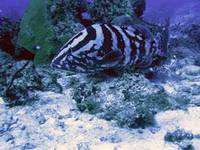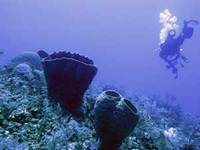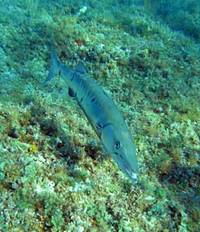April 22, 2005
No trace of sea turtles
The Ranger has arrived at Bimini (in the Bahamas) ahead of schedule, at 6:15 a.m. We couldn’t anchor until the first light of dawn. The wait was justified: it was important to be able to see the sandy seafloor before letting down the anchor because in this area, Ricardo explains, there are many sea grasses, and we have to take extreme precautions not to damage them.

I am writing these lines at the end of the day, because Friday the 22nd has been very intense. While Ricardo, Annie, David and I went on a reconnaissance mission in the dingy, the diving team was preparing two long dives, from which they returned brimming with excitement. Now we are recounting all of the day’s work. From the dives, we can remember some 40 species at the least and two dozen invertebrates, as well as a dozen types of algae and plants.
Oceana’s videographer, Mar Mas, is “mad” because Indi, the cook, had the great luck to see a nurse shark (Ginglimostoma cirratum). And she didn’t. “There are days when it turns out to be hard to be a woman,” she jokes, “and be trying to film backlighting in a tunnel.” The situation is that Mar has also missed the magnificent Nassau grouper (Epinephelus striatus) that the photographer, Houssine Kaddachi, did manage to capture. “Well, it wasn’t the best” – she admits – “but I did film all of the ecosystem that Ricardo requested, including a calico scallop, which is a commercial species here much appreciated in gastronomy.” It wasn’t a calico scallop, corrects the Director, but a flame scallop (Lima scabra). Mar has also come face to face with a graceful smooth trunkfish (Lactophrys triqueter), “blowing water out of its little mouth, and watching the sand intently, fixed in place like a hummingbird, agitating it in order to eat the little crustaceans among the suspended particles…”
But let’s see how it all happened.
10:00 a.m. Friday 22. The diving team is in motion once again. Finally they are going to do their first dive of the Ranger project after the long, and for them tedious, technical pause the Transoceanic Expedition was obliged to make in Florida. From the dingy, which we never lose from sight, Bibi calls to the boat just before the divers tumble into the water.
-`Ranger, Ranger, do you get me? Over.’
-`Ranger here. Over.’
-`There’s a buoy here and we’re moored to it. Do you see us?’
-`Affirmative, affirmative, we see you.’

Today we do two dives, the first in an underwater tunnel between 14 and 30 meters deep. “Underwater tunnels can be enormous. They create an interior passage, while the lateral rocks are full of filter-feeders,” Ricardo Aguilar explains to us.
Backlighting in a tunnel.
Down there, notes Mar, the play of light is fascinating. Intense reds, yellows, purples, the contrast between the white, blue and black…and then suddenly appear the silhouettes of a group of little fish, an elusive grouper. “Then, right in front of me, a rod of black coral two and a half meters tall – dazzling.”
The species we find in the tunnel are typical of open-water zones, like the bar jack (Caranx ruber), Bermuda chub (Kyphosus sectatrix), amberjack (Seriola dumerli); and others more typical of reefs like French grunts (Haemulon flavolineatum), Goliath grouper (Epinephelus itajara)…The ecosystem has three types of coral: soft, hard and black. Soft coral is much more flexible, while hard coral is rigid and can form reefs. Black coral species are very rare in the world of coral. They are so called because they generally have a type of bark, like trees. They secrete a protein, usually black in color, that hardens in concentric circles like the rings of a tree around the skeleton. And their polyps remain permanently outside; they don’t retract like the polyps of other corals.
The Oceana Expedition has also documented a lot of Halimeda, a type of green algae fundamental to the creation of coral reefs, because it has a calcic structure that, when the algae dies, supplies calcium to the corals to form their skeleton.
Rabbit Rock
The site of the second dive was a small underwater peak known as Rabbit Rock, which goes almost from the surface to a depth of 8-10 meters. Here we found a habitat comprised of three seaweeds: one sargassum (Sargassum polyceratium) and two types of turbinaria (Turbinaria turbinata y T. tricostata). “This is an ecosystem typical of coasts and shallow water, used by a multitude of species, especially juveniles. We saw everything from invertebrates to sponges, urchins, sea stars, and plume worms.”
“These last are similar and of the same family as the plume worms of European reefs, the sabelídos, or the beautiful tub worm of the Mediterranean. And many fish of every kind: triggerfish, squirrelfish, butteflyfish, surgeonfish, damselfish…

During the reconnaissance outing we saw no sea turtles, but we have had it confirmed that some have arrived in the waters of Abaco, next stop for the Expedition, especially hawksbill and green turtles. It’s more unusual to find a loggerhead at this time of year, because their nesting time is later. Apart from the turtles, we’ve come to Bimini because it is one of the important mating and nursery grounds for species like the Nassau grouper or sharks like the lemon shark (Negaprion brevirostris). The adults later travel to more oceanic zones. This is also a feeding ground for the hawksbill turtle (Eretmochelys imbricata), in fact we have seen many sponges with bites taken out of them, surely by this species of turtle.
Annie, Ricardo and I did have the luck to see the Nassau grouper that Mar wasn’t able to capture today on film. The name is taken from the capital of the Bahamas, and the species is distributed from here throughout the Caribbean. Due to its unusual beauty it has been much targeted by sportfishermen, but commercial fishing has also depleted the species, so that the Nassau grouper is ever more scarce throughout the area of its distribution.
As we arrived at one of the points we had wanted to study, we caught sight of a nurse shark (Ginglymostoma cirratum). Because its head is much wider than other sharks it appears more threatening, but the nurse shark is practically harmless. Very calm, it spends most of the time resting on the surface of the sea floor.
Indi had never seen a shark in its natural habitat. “It made an impression on me, because when you see it coming you think that maybe there are others coming, less pacifistic. It was thrilling. I was swimming level with the bottom and it suddenly appeared, surrounded by many surgeonfish (Acanthurus spp.) and grunts (Haemulon spp.), swimming with it like a retinue. I guess it was looking for food, it was about a meter and a half, grey with yellow.”
We also bumped into a pair of barracudas (Sphyraena barracuda). Barracuda are a very territorial species that spend their time in coastal zones, especially over sea grass or soft sandy bottoms, like here, where there is also so-called “turtle grass” (Thalassia testudinum). Ricardo Aguilar was very attentive to its movements. “I didn’t want to tell you, so as not to make you nervous, but it followed us, parallel, for 50 meters.”

